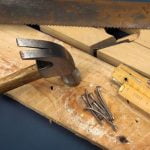Introduction
Woodworking has been around since the beginnings of civilization. Ancient Egyptian tombs from 5000 BC contain furniture crafted from various types of wood and tools used for woodworking. Craftsmen in Mesopotamia and Syria developed intricate woodwork designs, including bow lathe and carving techniques. During the classical period in Europe, craftsmanship significantly improved with the introduction of chisels, saws, drills, augers, and routers. By the Middle Ages, carpentry was a well-established profession, with highly skilled professional carpenters hand-cutting intricate patterns to adorn doors and cabinetry.
As technology advanced over time, mechanical powered tools such as band saws, planers, jointers and edge benders increased in popularity amongst professional woodworkers world-wide in order to produce complex furniture pieces faster than ever before. Due to its durability and beauty of natural grain patterns, wood is still one of the most popular materials used today when it comes to furniture design. With advances in CNC machining centers designers now have the ability to accurately create multiple pieces out of a single template which increases both quality consistency and efficiency substantially. Furthermore 3D CAD software has allowed contemporary craftspeople to develop thousands of unique shapes without ever having to touch a physical piece of wood.
Commonly Utilized Woods in Woodwork Design
Woodwork design is a unique and rewarding form of art that requires creativity, skill, and practice to be successful. While there is no one-size-fits-all approach when it comes to working with wood, there are some common woods that are used for furniture, cabinetry, and other projects. These include pine, oak, mahogany, walnut, cherry, maple, beech, ash, teak, and poplar.
Pine is an affordable wood with a light colour and attractive grain pattern. It is often used for building frames or shelves because of its good strength to weight ratio. Oak is a widely used wood that features a variety of tones and grains that can fit many designs. Mahogany has a beautiful deep reddish hue which can enhance antique pieces; due to its natural oils, it’s also highly resistant to decay. Walnut has light colours with dark veins running through it, making it an excellent choice for carved furniture pieces or cabinets. Cherry tends to have fine grain patterns which look attractive when highlighted with stains or finishes. Maple is more commonly associated with garden furniture as it’s very strong yet slightly lighter than oak or walnut; this makes it an ideal material for making large items like tables or chairs due to its weight capacity. Beech boasts a creamy white colour with subtle radiance that stands out in all forms of furniture such as desks and beds. Ash has high shock resistance making it great for building tools such as boxes or drawers as well as structural items like doors or window frames. Teak has special oils in the wood making it perfect for outdoor items since the wood will not rot even when exposed to the elements over time. Finally poplar usually has yellowish brown tints that give off an elegant tone when stained properly”this makes this type of wood great for luxury products like fine restaurants or bars since its colour keeps up well over time without fading away easily.
Steps for Getting Started with Woodwork Design
1. Choose the right wood – Before beginning with woodwork design, it is important to select the right wood for your project. Consider factors such as grain and shrinkage rates, as well as availability, price, and sustainability.
2. Design a plan – Brainstorm ideas and decide on a final design for the project before beginning. This can be done by sketching different drawings from various angles or using a computer-aided design (CAD) program to create a 3D model of the final product.
3. Gather materials and tools – Make sure that you have all of the necessary materials and tools needed for the project before getting started, including saws, drills, chisels, planes, sandpaper, etc.
4. Cut the pieces to size – Use measuring tools such as calipers or rulers to precisely measure each piece accurately according to your plans then cut them out with power saws such as circular saws or jigsaws if available. If not, hand saws can also be used depending on what is accessible to you.
5. Build frames/structures – Place pieces of wood together in a way that allows them to create strong frames or structures so they are able to stand on their own during construction phases of assembly even though all parts may not be permanently attached yet at this step.
6. Join pieces together – Using methods such as nail or screw fasteners or glue joiners attach two pieces of wood together in order to make a structure secure enough that it won’t easily fall apart under its own weight when complete.,br> 7 Finish product – Sand down any rough edges in order achieve smoothness then apply desired finishes such as stains, lacquers or paints in order to protect the surface and give it an attractive look
Practical Advice for Woodwork Design Beginners
Design is the foundation of any successful woodworking project. To get a good start, it’s important to get familiar with some of the basics of woodwork design that apply to all projects. First and foremost, proper preparation is essential for any woodworking project. Before beginning, measure out the space where you’ll be working and decide how much material you need for the project. From there, use a combination of hand and power tools to cut, join, and craft your material into your desired shape or pieces.
Once your pieces are initially cut and set in place, it’s important to take time to properly sand and smooth down surfaces so they lay flush with one another while still maintaining the characteristics of the material. Sanding should be done carefully either by hand through multiple passes or through an electronic sander that can easily control even pressure over all corners against the grain. Then use different types of stains, waxes, sealants or finishes to bring out color tones or producing a glossy shine based on what kind of look you’re looking for in your design at this stage.
Another key component of woodworking designs is creating joints between pieces. This can include dovetails for added hold when connecting two angled pieces together or dowel pinning which utilizes drill holes produced from a precise bit size matching dowel pins pressed into place with glue applied from both inside and outside surfaces resulting in a strong interlock adding extra support. These techniques will ensure that each joint holds its position over time without loosening up from wear-and-tear moments throughout its life cycle
Strategies for Improving Efficiency in Woodwork Design
Woodworking designers may face challenges when attempting to maximize their efficiency, but there are a few strategies they can implement to help in that process.
One of the primary strategies for improving woodworking design efficiency is utilizing automated wood cutting software. This type of software enables designers to quickly generate complex designs without having to manually cut and craft each piece individually. Additionally, it allows users to virtually store and organize their designs for quick reference or further adjustment should the project require it.
Another key strategy is pre-planning and organizing every step of the design process. This means breaking down the design into short steps with clearly defined objectives, such as drawing out all dimensions on paper, plotting out saw blade angles, listing required tools, etc., before getting started. Doing so ensures that no time is wasted due to confusion about the next step or unnecessary trips for additional materials mid-project.
Finally, woodwork designers should invest in quality tools and create an organized workspace. High quality tools provide precision which will save time and ensure accuracy; even something seemingly insignificant such as a dull saw blade can cause significant delays in progress if it’s not adequately sharpened beforehand. Similarly having an organized workspace and properly labeled containers also makes finding materials more efficient during cluttered phases of prototyping or assembly.
How to Maintain & Care for Woodwork Design Materials
Maintaining and caring for woodwork design materials is an important part of preserving the beauty and longevity of your wood pieces. Proper cleaning and care will keep your furniture, cabinets, doors, floors and other wood structures looking beautiful for years to come. Here are some tips on how to maintain and care for woodwork design materials:
1. Dusting: Regularly dust wooden surfaces with a soft cloth or foam roller to remove dirt, grime, grease and build-up. It’s also important to clean up spills as soon as possible in order to avoid staining or discoloration.
2. Cleaning: Use natural cleansers or commercial cleaning products specifically designed for wood surfaces when cleaning. Avoid using excessive amounts of soap, water or abrasive cleaners that can damage the finish or strip away protective coatings from the surface of your wooden materials.
3. Polishing: To maintain the original look and shine of your wooden projects you should apply a thin layer of wax or furniture polish every few weeks if needed. This also provides an extra level of protection against everyday wear and tear.
4. Preservation: Consider performing maintenance once a year by sanding away any existing damage, finishing imperfections and reapplying protective sealants like varnish or lacquer to make sure your wood products last as long as possible under regular use.
Ways to Monetize Woodwork Design Skills
1. Create custom designs and furniture pieces for clients: One of the most common ways to monetize woodwork design skills is by creating custom designs and furniture pieces for clients. These requests could be anything from a single piece of furniture to restoring an entire room or series of furniture pieces. This can be a great way to make money, as custom orders generally come with higher fees than mass-manufactured products.
2. Sell designs to retailers: If you prefer not to deal directly with customers, you might consider selling your woodwork designs to retailers instead. For example, you could put together an attractive portfolio of designs that could be sold or licensed to manufacturers or retailers who will then replicate these in mass production. This provides you with a recurring income stream without additional labor investment once the upfront work is done.
3. Publish how-to instructional manuals: An alternative way of monetizing your woodworking design skills is by publishing how-to guides or instructive manuals based on your expertise and experience in the craftsmanship industry. You could either produce physical copies of the manual or develop online versions, allowing people all over the world access to your material when they need it.
4. Teach classes: Teaching classes can be another great way for craftspeople to monetize their skills and share their knowledge with others interested in the subject matter. These can range from one-off sessions taught at local makerspaces, or extended certification courses offered through authoritative institutions or virtual academies based on your specialization in design techniques, materials selection and other specialties within the trade..
Creative Ideas for Different Types of Woodwork Design Projects
Woodwork design projects are the perfect way to embrace creativity. The possibilities are truly endless and can include anything from making basic furniture pieces to crafting intricate works of art. Different types of woodwork designs vary in difficulty level, so no matter what your skill level, there’s something to challenge you. Here are some general ideas for different projects:
• Beginner Projects ” Bookcases, end tables, benches, trays and even birdhouses are excellent beginner projects. These require minimal woodworking knowledge and supplies while still teaching you the basics and allowing you to have a sense of accomplishment when finished.
• Intermediate Projects ” Picture frames, side tables, picture frame mirrors and blanket ladders are all enjoyable intermediate projects. Each of these requires you to implement basic joinery techniques that can be applied to larger scale pieces as well as further your skills in forming the final product accurately and securely.
• Advanced Projects ” For those who already have a grasp on traditional woodworking methods, advanced or custom projects offer an opportunity to explore more complex concepts such as inlayed woods or alternative mortise-and-tenon construction styles. Modern furniture styles such as Japanese tables or Tetris shelving systems provide unique challenges that encourage creativity while also enhancing skillset and practice with different wood types and specialized joints.
• Specialty Projects ” If you want to create something truly extraordinary and unique, then specialty work can be very rewarding indeed! Items like carved wooden murals or furniture imbued with light features allow you to bring your ideas into fruition while also establishing yourself in a niche market (should you choose to take this route).
Influential People in the Woodwork Design Community
Within the field of woodwork design, there are a number of influential people who have had a major impact. These individuals think outside the box, pioneering new techniques and inspiring others to do the same. George Nakashima is one of the most famous names associated with woodwork design. He was known for his creative use of traditional functionality with modern materials. His designs often combined rich woods and were praised for their innovative use of natural forms to create beautiful, sleek works of art. Sam Maloof is another well-known designer who has made a big impact in the industry through his furniture designs that feature exceptional craftsmanship in both modern and classic styles. June Anderson is renowned for her intricate jigsaw puzzles made from exotic woods and possessing an exceptionally smooth finish due to her detailed attention to detail. Finally, Kari Christensen stands out with her unique technique that emphasizes the beauty in juxtaposition between different woods, finishes, and styles.
Summary & Recommendations for Woodwork Designers
Woodwork is a popular craft that requires a great deal of skill. Many designers are drawn to it because of its creative potential and sustainability. Woodwork can be used in both commercial and residential settings, adding character and beauty to any space.
As a woodwork designer, there are many considerations to consider before beginning your project: type of wood, tools and materials, finish application, design constraints, and cost analysis. With proper planning, you can ensure that the final product not only looks great but also stands the test of time. Here are some tips to help you get started:
1) Select the appropriate type of wood for your project. Different woods offer different levels of beauty and durability, so choose the right one for your needs. Additionally, make sure the wood you use is sustainably sourced to uphold ethical standards.
2) Familiarize yourself with a variety of tools and materials that will be necessary for executing your ideas. Choose quality options for longevity so you can be proud of your finished project for years to come.
3) Understand the implications associated with applying various finishes such as varnishes or lacquers onto different types of woods; this will help ensure an excellent end result that’s free from any staining or discoloration issues down the line.
4) Have strong knowledge about design constraints like weight limits, local codes and regulations, size parameters which might influence the success or failure of your project; ensuring these areas are properly met ensures that your designs safely pass all tests without fail!
5) Know how you plan on creating cost projections ahead-of-time in order to remain profitable while meeting deadlines as they’re set by clients; this includes calculating labor costs along with material expenses which might fluctuate depending on current market conditions or supplier demand changes too.
With careful planning and attention to detail into these five basic woodwork recommendations , designers should have the confidence that their projects will turn out beautiful yet sustainable creations that will stand up against wear-and-tear year after year!

Hi everyone! I’m a woodworker and blogger, and this is my woodworking blog. In my blog, I share tips and tricks for woodworkers of all skill levels, as well as project ideas that you can try yourself.





